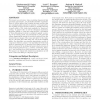Free Online Productivity Tools
i2Speak
i2Symbol
i2OCR
iTex2Img
iWeb2Print
iWeb2Shot
i2Type
iPdf2Split
iPdf2Merge
i2Bopomofo
i2Arabic
i2Style
i2Image
i2PDF
iLatex2Rtf
Sci2ools
GECCO
2009
Springer
2009
Springer
Combined structure and motion extraction from visual data using evolutionary active learning
We present a novel stereo vision modeling framework that generates approximate, yet physically-plausible representations of objects rather than creating accurate models that are computationally expensive to generate. Our approach to the modeling of target scenes is based on carefully selecting a small subset of the total pixels available for visual processing. To achieve this, we use the estimation-exploration algorithm (EEA) to create the visual models: a population of three-dimensional models is optimized against a growing set of training pixels, and periodically a new pixel that causes disagreement among the models is selected from the observed stereo images of the scene and added to the training set. We show here that using only 5 % of the available pixels, the algorithm can generate approximate models of compound objects in a scene. Our algorithm serves the dual goals of extracting the 3D structure and relative motion of objects of interest by modeling the target objects in terms...
Related Content
| Added | 24 Jul 2010 |
| Updated | 24 Jul 2010 |
| Type | Conference |
| Year | 2009 |
| Where | GECCO |
| Authors | Krishnanand N. Kaipa, Josh C. Bongard, Andrew N. Meltzoff |
Comments (0)

